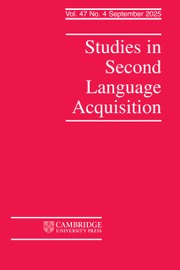No CrossRef data available.
Article contents
ANGLES ON THE ENGLISH-SPEAKING WORLD: WRITING AND VOCABULARY IN FOREIGN LANGUAGE ACQUISITION (Vol. 4)
Published online by Cambridge University Press: 26 January 2007
Extract
ANGLES ON THE ENGLISH-SPEAKING WORLD: WRITING AND VOCABULARY IN FOREIGN LANGUAGE ACQUISITION (Vol. 4). Dorte Albrechtsen, Kirsten Haastrup, and Birgit Henriksen (Eds.). Copenhagen: Museum Tusculanum Press, 2004. Pp. 151. $23.00 paper.
Comprised of eight research-based chapters and one book review, this volume brings together a compelling and unique array of research studies on two topics of ongoing interest to second language (L2) professionals. The volume opens with three L2 writing studies, the first two of which draw from the same investigation of university and preuniversity English as a second language (ESL) writers. The first chapter, “Activity Systems for ESL Writing Improvement: Case Studies of Three Chinese and Three Japanese Adult Learners Of English,” is co-authored by Yang, Baba, and Cumming. Using an activity theory framework, the researchers explore writers' perceptions of their learning intentions, crosslinguistic relationships, vocabulary, grammar, and the role of instruction in promoting their L2 composing skills. As the participants progressed in their ESL writing development, their activity systems evolved as a function of the interaction between external factors and internal predispositions. In the second chapter, “Scaling Changes in Learners' Goals for Writing Improvement over an ESL Course,” Cumming, Eouanzoui, Gentil, and Yang report on an analysis of interviews conducted with 45 preuniversity ESL writers. Their method featured dual scaling, which showed that participants' short- and long-term goals as students and writers remained stable over time, although the actions taken by students to improve their writing reflected individual learning styles.
Information
- Type
- REVIEWS
- Information
- Copyright
- © 2007 Cambridge University Press

